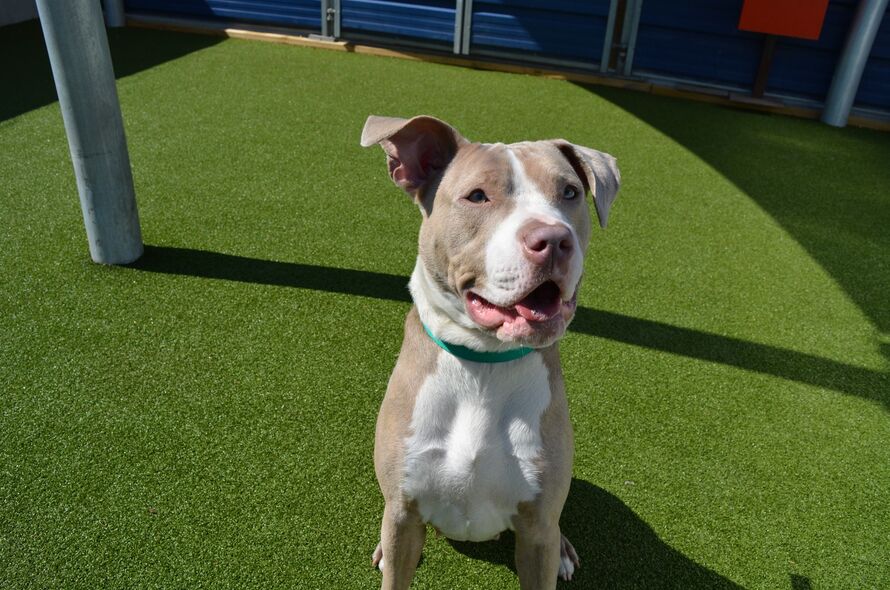
Battersea Campaigns to End Laws That Target Dogs Based on Their Breed
August 2021 marked the 30th anniversary of the much-criticised Dangerous Dogs Act 1991 – legislation brought in to tackle dog attacks on people.
At Battersea, we have long questioned whether the Dangerous Dogs Act has been effective, whether the law is fair, and what could work better. After all this time dog bite incidents continue to rise, going from 3,079 in 1999 to 8,859 in 2020 – an 188% increase.
Background
The Dangerous Dogs Act was quickly passed through Parliament following a series of tragic incidents in the early 1990s. It has since been criticised as poorly thought-out, reactionary legislation that does not do what it sets out to achieve. The Act set out to improve public safety by:
- Making it a criminal offence to allow a dog to be dangerously out of control in a public place (Section 3)
- Outlawing four dog breed types – dogs of the types known as the Pit Bull Terrier, Japanese Tosa, Dogo Argentino and Fila Brasileiro (Section 1).
The offences under Section 1 of the Act, known as Breed Specific Legislation or BSL, have been particularly controversial on the grounds that they can result, and often have, in the destruction of healthy and good-natured animals with little added protection to the public. This is because the assessment of what constitutes a "dangerous dog" under the Act is principally based on how the animal looks.
Battersea’s non-selective intake policy means we take in any dog in need of our care, including significant numbers of banned types. We see the heart-breaking impact of this legislation in our work in the sheer number of Section 1 dogs that have come through our centres since the Dangerous Dogs Act was passed.
When a dog that could be of banned type arrives at our gates, by law it has to be assessed by an external expert witness, which may be a Police Dog Legislation Officer. This expert witness will determine whether it is a Section 1 dog and, if it is, we are legally obligated to put the dog to sleep.
For an organisation of dog-lovers, this is crushing. Not only is it deeply unfair for the many well-behaved, sweet natured dogs that come to our centres, these decisions and processes also take an enormous toll on our caring staff.
ASKING THE EXPERTS
Back in 2016, Battersea conducted a survey of 215 dog behaviourists and trainers to provide an informed and contemporary view of the causes of dog bites to people, including the role of breed. We also explored what measures might prevent them in the future.
In these experts’ opinions, when looking at causes of dog bites:
- 74% said that breed was either not important at all or only slightly important in determining dog aggression levels.
- Upbringing of the dog is the critical factor – 86% said that the way it is brought up by its owner is the most important factor in a dog’s aggression towards people, while 73% said it is linked to a dog’s upbringing by the breeder before it is sold.
- For those who felt that some breeds could be more aggressive, there was little agreement on which breeds were most aggressive, with collies and small terriers cited as often as German Shepherds, bull breeds, and perceived ‘guarding breeds’. This makes it strange that the law characterises four breeds as the most innately aggressive and condemns these dogs as a result.
The experts said education was key to prevention of dog bites:
- 87% said that educating the owners and others on how to read dog body language is crucial for preventing dog bites, with even a small amount of understanding likely to have an impact.
- 78% supported the compulsory training of new dog owners.
You can find out more about the impact of dog breeds on bites in our report.
FIGHTING TO CHANGE THE LAW
Having fought against this law since it was first introduced in 1991, Battersea is horrified at the ongoing requirement to put innocent dogs to sleep. In May 2018 Battersea responded to an EFRA Committee inquiry on the topic of Breed Specific Legislation. We argued that Breed Specific Legislation should be repealed as:
- It has been proven to be ineffective at reducing incidence of dog attacks.
- It is arbitrary and unfair – it is based on type that only takes into account physical characteristics, so two dogs from the same litter can be (and sometimes are) viewed differently, one could be identified as a banned type while the other is not, despite having the same parents and genetics.
- It is not based on scientific fact.
While the Committee agreed with our response, the Government rejected the call to repeal Breed Specific Legislation. Ministers argued that these breeds were involved in a disproportionate number of attacks but have never brought forward the evidence to support that claim.
RECOMMENDATIONS FOR THE FUTURE
Battersea recommends the following:
- Following a review of how the law on dangerous dogs operates, Section 1 of the Dangerous Dogs Act 1991 should be repealed. Breed-specific legislation (BSL) cannot be justified – the vast majority of behaviourists agree that breed is not the determining factor in dog attacks. Furthermore, the current law has palpably failed to protect the public, despite the iniquities it brings, as dog bite incidents continue to rise.
- In the wrong hands, any dog has the potential to bite. Any future change in the law needs to concentrate on the person in charge of the dog rather than any assumption about a dog’s behaviour because of its looks.
- The current laws on dog control are confusing, with different legislation stretching back over a century meaning a lack of clarity and challenges for enforcement. These should be consolidated into one dog law.
- Introduce Dog Control Notices, similar to those currently used in Scotland, to target people whose dogs aren’t being kept under proper control.
Even while Section 1 remains, Battersea believes that it could be made fairer with the following changes and considerations:
- Currently the onus is on the owner of a potential banned type to prove that the dog is not of an illegal type. This should revert to the usual position whereby the police have to prove on the criminal standard (beyond reasonable doubt) that the dog is one to which Section 1 applies.
- It is currently illegal to give away or sell a Section 1 dog unless the dog has been exempted and the owner is deceased or severely unwell or impaired, making it impossible to look after it. Even then, it can only be transferred to a “natural person” who is already known to the animal and deemed fit and proper by the Courts. We believe it should be made legal to give away or sell a Section 1 dog when this is coupled with clear police and Court consent.
- Currently, it is only possible to obtain an exemption to keep a banned breed type by Court Order. Battersea believes that it should be possible to negate the requirement for a Court and keep the dog, if the Police agree, provided they are satisfied the dog is not a threat to the public.
- Given the lengthy time taken for some Section 1 cases to reach a resolution, owners should be allowed to apply to the Court for their dogs to be released on "bail" pending the conclusion of the case. Kennelling away from their owners for long periods can lead to development of negative behaviours that were not originally there.
- Remove the power to add more types/breeds to the list of banned dogs.

